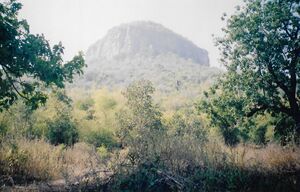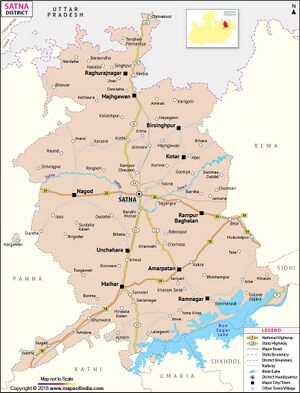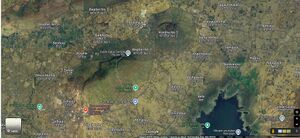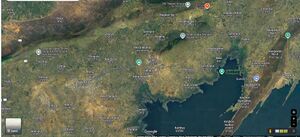Gidhaula Pahad
| Author: Laxman Burdak IFS (R) |




Gidhaula Pahad (गिधौला पहाड़), near Gidhaila (गिधैला) village, is a hill in Ramnagar tahsil of Satna district in the Madhya Pradesh. In ancient literature it was called Griddhraj Parvat (गृद्घराज पर्वत).
Variants
- Gidhaila (गिधैला)
- Gidhaila Pahad (गिधैला पहाड़)
- Griddhanchala Parvata (गृद्धांचल पर्वत)
- Griddharaja Parvata (गृद्घराज पर्वत)
- Gridhrakuta Hill
Origin
Location
Gidhaula Pahad is a small Village/hamlet in Ramnagar Tehsil in Satna District of Madhya Pradesh State, India. It comes under Gidhaula Pahad Panchayath. It belongs to Rewa Division . It is located 58 KM towards South from District head quarters Satna. 8 KM from Ramnagar. 464 KM from State capital Bhopal Gidhaula Pahad Pin code is 485881 and postal head office is Ramnagar (Satna). Gidhaila ( 3 KM ) , Sagauni Khurd ( 6 KM ) , Joba ( 6 KM ) , Ganga Sagar ( 6 KM ) , Gulwar Gujara ( 7 KM ) are the nearby Villages to Gidhaula Pahad. Gidhaula Pahad is surrounded by Amarpatan Tehsil towards North , Beohari Tehsil towards South , Rewa Tehsil towards North , Maihar Tehsil towards west.[1]
Griddhraj Parvat
Griddhraj Parvat (also called, Gridhrakuta Hill or locally known as Giddhaila Pahar) (English: Vulture Peak, Hindi: गृद्घराज पर्वत), which literally means the hill of vultures, is a hill of religious, archeological and ecological importance situated near Deorajnagar village of tehsil Ramnagar in Satna district of Madhya Pradesh, India.
It is located at a distance of 8 km from Ramnagar town and 65 km from Satna in south direction. Its latitude and longitude are 24°18' North and 81°15' East. The altitude of the hill is 2354 feet. The hill is situated between Kaimur Range in the north and Maikal hills in the south.
The place is of archaeological importance. There are four caves on the hill in which Rock painting and mural paintings are visible.
An annual fair is organized every year in the month of Magha on the occasion of Vasant Panchami. Thousands of people come and take a dip in the Ganges River.
In Hindu mythology
Griddhraj Parvat is of great religious importance in Hindu mythology. It has been mentioned in Skanda Purana as ‘Griddhanchal Parvat’ (page 208). It is believed to be the birthplace of ‘Sampati’, the brother of Griddhraj ‘Jatayu’ mentioned in Ramayana. The poet Kalidas mentions about this place as the most sacred in his book ‘Griddharaj Mahatmya’ (Narad Uvach) in Sanskrit language. He has written that a dip in the Mānasī Ganga River originating from Griddhraj Parvat, at an altitude of 2354 feet, is a saviour of all kinds of sins. Sons of Brahma and then goddess Parvati first saw this hill. It finds mention in Shiva Samhita (Chapter 19-Bhoogol varnan).
Mention by Fa-hien
Chinese Buddhist pilgrim Faxian (Fa-hien) had visited probably a different, Buddhist holy place with the same name (Vulture Peak in Rajgir, and has mentioned it as Gridhra-kuta Hill in Chapter XXIX (see also James Legge): Chapter XXIX : GRIDHRA-KUTA HILL, AND LEGENDS. FA-HIEN PASSES A NIGHT ON IT. HIS REFLECTIONS.
- "Entering the valley, and keeping along the mountains on the south-east, after ascending fifteen le, (the travellers) came to mount Gridhra-kuta.(1) Three le before you reach the top, there is a cavern in the rocks, facing the south, in which Buddha sat in meditation. Thirty paces to the north-west there is another, where Ananda was sitting in meditation, when the deva Mara Pisuna,(2) having assumed the form of a large vulture, took his place in front of the cavern, and frightened the disciple. Then Buddha, by his mysterious, supernatural power, made a cleft in the rock, introduced his hand, and stroked Ananda's shoulder, so that his fear immediately died. The footprints of the bird and the cleft for (Buddha's) hand are still there, and hence comes the name of "The Hill of the Vulture Cavern."
In Buddhist Literature
Vulture Peak Mountain is, by tradition, one of several sites frequented by the Buddha and his community of disciples for both training and retreat. Its location is frequently mentioned in the Buddhist sutras both in the Theravada]] Pali Canon[2] [3]and in the Mahayana sutras, as where the Buddha gave a particular sermon. Among the latter are the Heart Sutra, the Lotus Sutra and the Suramgamasamadhi sutra, as well as many other Prajnaparamita Sutras.
It is explicitly mentioned in the Lotus Sutra in Chapter 16 as the Buddha's "Pure Land":[4]
And when the living have become faithful,
Honest and upright and gentle,
And wholeheartedly want to see the Buddha,
Even at the cost of their own lives,
Then, together with the assembly of monks
I appear on Holy Eagle Peak.
...
Such are my divine powers.
Throughout countless eons,
I have always lived on Holy Eagle Peak
And in various other places.
When the living witness the end of an eon,
When everything is consumed in a great fire,
This land of mine remains safe and tranquil,
Always filled with human and heavenly beings.
Habitat of vultures
Griddhraj Parvat is a unique habitat of vultures not only in India but the world also. Vultures in number of thousands can be seen in the crevices of the hill rocks. The vulture species seen here are long billed vulture (Gips indicus) and White backed vulture (Gips bengalensis). Apart from vultures it is also the habitat of number of wild animals.
Further reading
- Jitan Singh Diwan, Kothi State, 1907: Rewa Rajya Darpan
- Kalidas : Griddharaj Mahatmya (Narad Uvach)
- Shiva Samhita (Chapter 19-Bhoogol varnan)
- JAMES LEGGE: A RECORD OF BUDDHISTIC KINGDOMS, Being an Account by the Chinese Monk Fa-Hien of his Travels in India and Ceylon (A.D. 399-414) in Search of the Buddhist Books of Discipline
लेखक का गिधैला पहाड़ प्रवास
अक्टूबर 2006: राम को हम अगर इतिहास पुरुष मानें तो उनके जीवन में सबसे बड़ा योगदान मध्य प्रदेश के सतना जिले का है क्योंकि रामायण में वर्णित अनेक स्थान मध्य प्रदेश के सतना जिले में स्थित हैं. आयुक्त बाणसागर रीवा पदस्थापना के दौरान लेखक (लक्षमण बुरड़क) का गिधैला पहाड़ जाना हुआ जो सतना जिले में रामनगर तहसील में स्थित था. रामनगर तहसील के अनेक गाँव बाणसागर परियोजना रीवा के डूब क्षेत्र में आ गये थे. अकेले सतना जिले के 50 गाँव पूर्ण रूप से बाणसागर में जलमग्न हो गए थे जिनका अब कोई अस्तित्व नहीं रहा यद्यपि उन्हीं गाँवों के नाम पर अन्यत्र नए गाँव बसाए गए थे.
रामनगर तहसील के डूब में आये गाँवों के निरीक्षण के परिपेक्ष्य में ही हम गिधैला और देवराज नगर गाँव गए थे जिनके पास ही गिधैला पहाड़ है जिसकी छोटी दूर से दिखाई पड़ती है. इस पहाड़ का नाम गिद्धराज पर्वत भी है. स्थानीय लोग इसे गिधैला पहाड़ बोलते हैं. यह बहुत संख्या में गिद्धों का आवास है इसीलिए गिधैला पहाड़ नाम पडा.
अक्टूबर 2006 में हम उस पहाड़ पर उत्तर की ओर से चढ़े. मेरे साथ श्रीमती गोमती बुरडक भी थी. साथ में बाणसागर रीवा के अधीक्षण यंत्री एस के पाठक, कार्यपालन यंत्री जे एस राजपूत और अन्य 10 कर्मचारी भी थे. अधीक्षण यंत्री एस के पाठक कुछ चढ़ाई चढने के बाद थक गए और रास्ते में ही 5 कर्मचारियों सहित रुक गए. पहाड़ की उत्तर की तरफ से चढ़ाई बहुत कठिन और खड़ी थी. एक जगह कोई 20 फुट ऊँची लोहे की सीधी खड़ी सीढ़ी भी थी जिसपर होकर ऊपर रास्ता था. कुछ घंटों में हम पहाड़ पर चढ़ने में सफल रहे.
गिधैला पहाड़ पर एक छोटा सा पक्का सिद्ध बाबा का मंदिर बना है जिसमें लगातार पानी आता है. बताया गया कि यह पानी एक नदी का है जिसका नाम मानसी गंगा है. वहां मंदिर में एक बाबाजी रहते थे. ऊपर थोडा पठार है जिसपर कुछ खेती होती है और बाबाजी ने दूध के लिए गाय भी रखी हुई थी. बाबाजी ने श्रीमती गोमती बुरडक के लिए कहा कि आप दूसरी महिला हैं जो इस पहाड़ पर चढ़ी हैं और सीधा पैदल चढने वाली तो पहली महिला ही हैं. आपसे पहले आने वाली महिला उमा भारती थी जो उस समय मध्य प्रदेश की मुख्य-मंत्री थी और वह हेलिकोप्टर से पहाड़ पर उतरी थी.
बाबाजी ने मानसी गंगा का शुद्ध पानी पिलाया और गाय के दूध की अच्छी चाय पिलाई. बाबाजी ने बताया कि इस पर्वत का बहुत धार्मिक महत्व है. रामायण काल में जटायु के भाई संपाती इस पहाड़ पर रहते थे.
बाबाजी ने संपाती के बारे में बताया ....सीता की खोज में गए सभी वानर और भालू अपने को असहाय पाकर तरह-तरह की निराशापूर्ण बातें कह रहे थे. ... सभी वानरों की बात पहाड़ पर बैठे एक बहुत बड़े गिद्ध ने सुनी तो उसने कहा कि मुझे आज भगवान ने बहुत भोजन दे दिया है. मैं तुम लोगों को एक-एक कर खाऊंगा. गिद्ध की बात सुनकर सबने जटायु की बात बताई कि किस तरह उसने अपनी जान पर खेल कर दुष्ट रावण से सीता जी को छुड़ाने का प्रयत्न किया था किंतु रावण ने उसे मार डाला. दंडक वन में राम ने उसकी अंतिम [पृ.183]: क्रिया की थी. हम लोग मां सीता की खोज में आए हैं. जटायु की बात सुनकर गिद्ध ने बताया कि वह मेरा छोटा भाई था, मेरा नाम संपाती है. मेरे पंख जल गए हैं इसलिए मैं उड़ नहीं सकता. तुम लोग मुझे उठाकर समुद्र के पास ले चलो जिससे मैं अपने भाई को जल से तिलांजलि दे सकूं. फिर मैं तुम लोगों को सीता माता को ढूंढने में मदद करूंगा. गिद्धों की दृष्टि अपार होती है और मैं देख सकता हूं कि सीता अशोक वाटिका में रावण की लंका में बैठी हुई है. जो भी इस 100 योजन सागर को उड़कर जा सकेगा वह सीता की खोज कर सकेगा.[5]
गिधैला पहाड़ का महत्व : गिधैला पहाड़ के धार्मिक महत्व के बारे में भारतीय साहित्य में उल्लेख मिलता है. स्कन्द पुराण (p.208) में इसको गृद्धांचल पर्वत (Griddhanchala Parvata) लिखा है. किंवदन्ती के अनुसार यह स्थान रामायण में वर्णित गृद्धराज जटायु के भाई सम्पाती का जन्म स्थान माना गया है. कालीदास ने संस्कृत में लिखित 'गृद्धराज महात्म्य' (नारद उवाच) में इस स्थान को सबसे पवित्र स्थानों में वर्णित किया है तथा लिखा है कि गृद्धराज पर्वत से उद्गम होने वाली मानसी गंगा नदी में स्नान से सभी पापों से मुक्ति मिलती है. ब्रह्मा के पुत्रों और देवी पार्वती ने ही सर्वप्रथम इस पर्वत को देखा था. शिव संहिता (अध्याय-19 भूगोल वर्णन) में इस पर्वत का उल्लेख है.
गिधैला पहाड़ से देखने पर नीचे दूर तक बहुत सुन्दर दृश्य दिखता है. बाण सागर झील का नजारा देखते ही बनाता है जो 2006 वर्षाकाल में पूरा हुआ है. सामने एक पहाड़ और दिखता है जिसमें काफी संख्या में गिद्ध निवास करते हैं, इस पर्वत पर हज़ारों गिद्ध पाये जाते हैं, जो इसकी चट्टानों में अपने बसेरे स्थापित करते हैं. यहाँ गिद्धों की दो जातियाँ - भारतीय गिद्ध और बंगाल का गिद्ध - पाई जाती हैं. इन गिद्धों के संरक्षण के लिए वन विभाग द्वारा योजना बनाई जा रही है.
कुछ समय पहाड़ पर बाबाजी के साथ व्यतीत करने के पश्चात उनको धन्यवाद देकर हम पहाड़ के दक्षिण की तरफ से देवराज नगर और रामनगर की तरफ से उतरने वाले रास्ते से नीचे उतरे. यह रास्ता अपेक्षाकृत कम ढालवाला और आसान था. रामनगर में वन विभाग के विश्राम गृह में कुछ देर रुके और जनता की शिकायतें सुनी. रात को हम वापस रीवा आ गए. यह विश्राम गृह बाणसागर रीवा की सहायता से ही वन विभाग ने निर्माण कराया है.
गिधैला पहाड़ स्थान पुरातात्विक दृष्टि से महत्वपूर्ण है. इस पहाड़ी में चार गुफाएँ हैं जिनमें शिला चित्रण (रॉक पेंटिंग) तथा मुराल पेंटिंग देखे जा सकते हैं. हर वर्ष माघ महीने की वसन्त पंचमी के दिन यहाँ मेला लगता है. हजारों लोग मेले में आते हैं और स्थानीय गंगा (मानसी गंगा नदी) में स्नान करते हैं.
श्री एस बी सिंह, सेवा निवृत कार्य पालन यंत्री रीवा, ने बताया कि किंवदंती के अनुसार सम्पाती एवं जटायू दोनों सगे भाई थे. सम्पाती बड़े तथा अपेक्षाकृत अधिक बलवान थे. तरुणावस्था में दोनों सूर्य को नजदीक से देखने के उद्देश्य से एक साथ उड़े. काफी ऊंचाई पर जाने पर सूर्य की गर्मी को न सह सकने और थक जाने के कारण जटायू जनस्थान, जो पंचबटी के पास था तथा उनका निवासस्थान भी था, वापस लौट आए परन्तु सम्पाती उड़ान जारी रखते हुए सूर्य के निकट पहुंचने के प्रयास में पंख जल जाने के कारण दग्धावस्था में दक्षिणी समुद्र तट पर स्थित विन्ध्य पर्वत श्रृंखला के ऊंचे पहाड़, जो वर्तमान तमिलनाडु में है, पर गिरे जिन्हें एक महान ऋषि निशाकर ने स्वस्थ चित्त कर जिजीविषा से सम्पन्न किया. कालान्तर में सीता जी का रावण द्वारा अपहरण होने तथा उनके अन्वेषण हेतु अंगद के नायकत्व में सुग्रीव द्वारा भेजी गयी वानर टोली से समुद्र के उसी तट पर सम्पाती से भेंट होने तथा उनके द्वारा सीता जी के लंका में होने की पुष्टि करने और वानरों को लंका में जाने हेतु प्रोत्साहित करने पर हनुमान जी द्वारा लंका में जाकर सीता जी की खोज की गयी थी. इस कथानक का विस्तृत वर्णन वाल्मीकि रामायण में है.
जहां तक सतना जिले की रामनगर तहसील में स्थित गिद्धराज पर्वत की बात है गिद्धों के समूह का वहां निवास होना स्वाभाविक प्रतीत होता है. वास्तव में उक्त पहाड़ स्थानीय जनश्रुति में प्रचलित नाम गिधैला है जिसे किसी भद्र व्यक्ति ने अर्थवत्तापूर्ण नाम दे कर सम्पाती से सम्बद्ध कर उसे पौराणिक सन्दर्भ देने का प्रयास किया है ऐसा लगता है.
Gallery
-
गिधैला पहाड़ का नीचे से दृश्य
-
गिधैला पहाड़ से नीचे का दृश्य
-
गिधैला पहाड़ पर सिद्ध बाबा का आश्रम
-
गिधैला पहाड़ पर श्रीमती गोमती बुरड़क
-
गिधैला पहाड़ से नीचे का दृश्य
-
गिधैला पहाड़ के समीप दूसरे पहाड़ का दृश्य
References
- ↑ http://www.onefivenine.com/india/villages/Satna/Ramnagar/Gidhaula-Pahad
- ↑ "The Sona Sutta: About Sonal
- ↑ The Daruka-Khanda Sutta: The Woodpile
- ↑ Vakkali Sutta of the Pali Canon
- ↑ राम वन गमन (पुनरावलोकन), लेखक: डॉ. रामगोपाल सोनी IFS: , प्रकाशक: ऋषिमुनि प्रकाशन, उज्जैन, प्रथम संस्करण: 2021, ISBN: 9788794990338 p.182-183
External links
Back to Jat Villages







